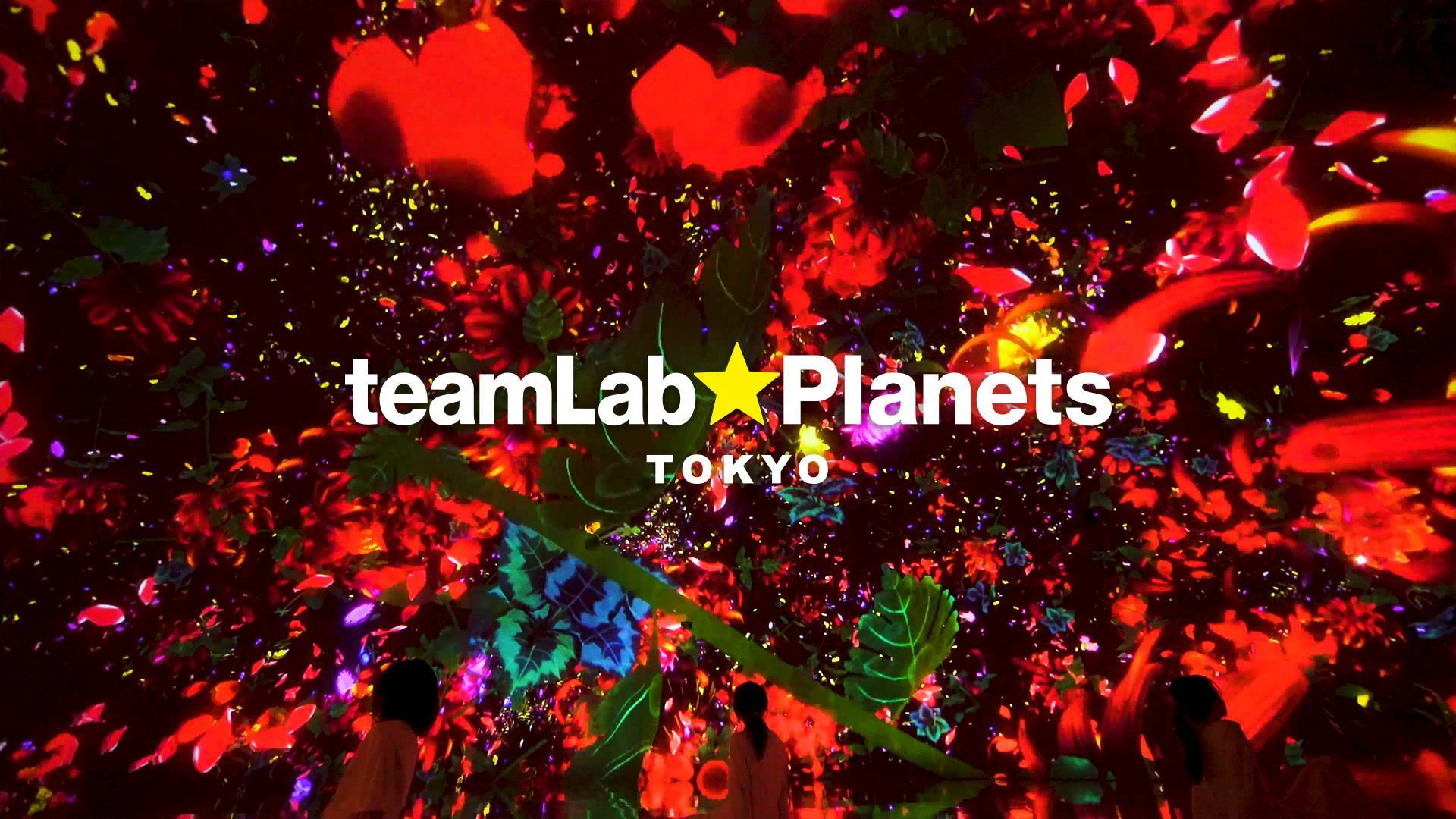teamLab Planets TOKYO
The definition and creation of Art is changing before our very eyes and in today's world the key application is interaction or immersion. This is the approach being taken even for static exhibitions such as traditional paintings or sculptures presented in an "exhibition". Now we are encouraged through labels associated with the works to read about the context of the work, the perception and vision of the artist in producing the work etc. No longer do we stand back and just admire but rather we become immersed in a theme or context!!
But today is about the emergence of more and more interactive visual installations which are being constructed in such a way that you can literally immerse yourself in colour, line, shape through advances in technology which allow worlds to be created through the use of immersive LED displays. In the light of this, today we will look at an art form experienced by some young people I know who have been visiting Japan and found themselves engulfed in a world without boundaries.1
This is the video recording of their experience where they accepted the invitation to: Together with Others, Immerse your Entire Body, Perceive with your Body, and Become One with the World as the promotion for teamLab Planets advertises. 1
"teamLab Planets" is a museum where you walk through water, and a garden where you become one with the flowers. It comprises 4 large-scale artwork spaces and 2 gardens created by art collective teamLab.1
People go barefoot and immerse their entire bodies in the vast artworks together with others. The artworks change under the presence of people, blurring the perception of boundaries between the self and the works. Other people also create change in the artworks, blurring the boundaries between themselves and the works, and creating a continuity between the self, the art, and others.1
The Art Works involve a Water Area, a Garden Area and a Public Area.
The Water Area is described as:
Drawing on the Water Surface Created by the Dance of Koi and People - Infinity
(Credit: teamLab, 2016-2018, Interactive Digital Installation, Endless, Sound: Hideaki Takahashi)
Koi swim on the surface of water that stretches out into infinity. People can walk into the water.
The movement of the koi is influenced by the presence of people in the water and also other koi. When the fish collide with people they turn into flowers and scatter. Throughout a year, the flowers that bloom will change along with the seasons.
The trajectory of the koi is determined by the presence of people and these trajectories trace lines on the surface of the water.
The work is rendered in real time by a computer program. It is neither prerecorded nor on loop. The interaction between the viewer and the installation causes continuous change in the artwork. Previous visual states can never be replicated, and will never reoccur.1
The Garden Area is described as:
Floating Flower Garden: Flowers and I are of the Same Root, the Garden and I are One
(Credit: teamLab, 2015, Interactive Kinetic Installation, Endless, Sound: Hideaki Takahashi; Orchids(except Vanda and Renanthera): Haruyuki Kato(Zama Orchids Center)
Vanda and Renancera: Kazuki Kaneta(moku), Yoshinobu Ueda(ACRE8) , teamLab)
This floating flower garden consists of a three-dimensional mass of flowers.
The artwork space is completely filled with flowers, but as the flowers float up above people, open spaces are created. Because of this, people are able to freely wander around the flower mass space. If you encounter other people within the artwork, your space will connect with theirs and become one single space.
Zen gardens are said to have been created as a place for groups of Zen priests to carry out training in order to become one with nature. There is a Zen kōan (a question or story that is part of Zen priests’ theological training) called "Nansen’s Flower." Someone asked the monk Nansen about the famous saying, “Heaven and I are of the same root. All things and I are of the same substance,” remarking on how wonderful it was. Nansen, pointing to a flower in the garden, said, “People these days see this flower as if they were in a dream."*
In this work, people immerse themselves in flowers, becoming one with the garden. When someone continues to look at a flower closely, the flower looks back. At that moment, they become one with the flower and may truly see flowers for the first time.
The flowers in this artwork are orchids. Most orchids are able to grow without soil by absorbing water from the air. The flowers in this artwork are alive, growing, and blooming with each passing day. It could be said that they are growing in mid-air.
Flowering plants were the last of the plant species to appear on earth. And orchids were the last of the flowers to appear, which means they are the most evolved plants. Since orchids were the last to appear, the soil was already full of other plants. Because of this, orchids evolved to live on rocks and trees where other plants could not survive. It could be said that orchids are flowers that have evolved to live without soil. They also have the most variety of any plant. It is said that about 10% of all plant species on land are in the orchid family. To begin with, at least 220,000 of the 250,000 land plant species were flowering plants. Evolution selects for diversity, and it can be said that flowers are born to produce diversity. The most evolved orchids have chosen a diversity that overwhelms all other flowers, and it is that diversity that has allowed them to evolve to survive in a variety of places where no other plants exist. This makes us wonder what evolution favored.
Orchids are known to have co-evolved with certain pollen-carrying insects. The flowers’ aromas become stronger at the time of day when the partner insects are active.Because of this, the scent of the artwork space changes each moment between morning, day, evening, and night. Since many of the orchids in this work are partnered with nocturnal insects, the fragrance from the tightly-packed orchids at night is incredible.1
The Public Area is described as:
Universe of Fire Particles Falling from the Sky
(Credit: teamLab, 2021, Interactive Digital Installation, W6000mm D6000mm H15000mm, Sound: Hideaki Takahashi)
When people stand on the work, a black absolute presence is created, and the shape of the flames change. The work is affected by people, and is in a state of perpetual, continuous change.
Flames are a phenomenon of light and heat generated by combustion; it is a vaporized substance in a flow, a decomposed substance. It is our sensory experience of seeing what is in between phenomenon and substance.
Lines are drawn in relation to the flow of combusting gas, and the flames are created by the accumulation of those lines in three-dimensions. The lines are then “flattened” using what teamLab considers to be Ultrasubjective Space to represent the flames.
teamLab is exploring the concept of Distributed Art.
If you launch the Distributed Fire smartphone application and approach this artwork, the flame will ignite and you can take the artwork home with you. When you bring that flame close to another person's smartphone, a flame will alight. As you connect the flame, and they connect that flame with someone else, the flame will spread all over the world. The flames that are spread are displayed on the Map of The Flame.
Distributed Art duplicates itself, or a part of an artwork is distributed among people. Then, once in the hands of the people, the artwork is further actively distributed, and also makes copies of itself. The artworks will be distributed and exist on people's networks and become decentralized. When the artwork exists on the network, it continues to exist even if the original disappears.1</
This application of technological knowledge and creativity is really mind blowing and exciting as it redefines what it means to be an artist and to make art.
Follow the bookmark link below to check out the site especially if you are off on a holiday to Japan.

And for those of you interested in the background to teamlab check out their site through this bookmark link.

Credit
1. planets.teamlab.art
